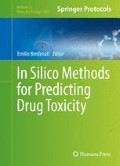Abstract
Information on genotoxicity is an essential piece of information gathering for a comprehensive toxicological characterization of chemicals. Several QSAR models that can predict Ames genotoxicity are freely available for download from the Internet and they can provide relevant information for the toxicological profiling of chemicals. Indeed, they can be straightforwardly used for predicting the presence or absence of genotoxic hazards associated with the interactions of chemicals with DNA.
Nevertheless, and despite the ease of use of these models, the scientific challenge is to assess the reliability of information that can be obtained from these tools. This chapter provides instructions on how to use freely available QSAR models and on how to interpret their predictions.
Access this chapter
Tax calculation will be finalised at checkout
Purchases are for personal use only
References
Moore MM, Myers MB, Heflich RH (2000) Mutagenesis and genetic toxicology. In: Williams PL, James RC, Roberts SM (eds) Principles of toxicology: environmental and industrial applications, 2nd edn. Wiley-Interscience, New York, pp 239–264
Sutter A, Amberg A, Boyer S et al (2013) Use of in silico systems and expert knowledge for structure-based assessment of potential mutagenic impurities. Regul Toxicol Pharmacol 67:39–52
Regulation (EC) No. 1907/2006 of the European Parliament and of the Council, of December 18, 2006 concerning the Registration, Evaluation, Authorization and Restriction of Chemicals (REACH), establishing a European Chemicals Agency, amending Directive 1999/45/EC and repealing Council Regulation (EEC) No 793/93 and Commission
Ames BN, McCann J, Yamasaki E (1975) Methods for detecting carcinogens and mutagens with the salmonella/mammalian-microsome mutagenicity test. Mutat Res 31:347–364
Claxton LD, Umbuzeiro GA, DeMarini DM (2010) The Salmonella mutagenicity assay: the stethoscope of genetic toxicology for the 21st century. Environ Health Perspect 118:1515–1522
Benigni R, Bossa C, Battistelli CL et al (2013) IARC classes 1 and 2 carcinogens are successfully identified by an alternative strategy that detects DNA-reactivity and cell transformation ability of chemicals. Mutat Res 758:56–61
OECD (1997) Test No. 471: bacterial reverse mutation test, OECD guidelines for the testing of chemicals, section 4. OECD Publishing, Paris
Piegorsch W, Zeiger E (1991) Measuring intra-assay agreement for the Ames Salmonella assay. In: Hotorn L (ed) Statistical methods in toxicology, lecture notes in medical informatics, vol 43. Springer-Verlag, Berlin, pp 35–41
Sushko I, Novotarskyi S, Körner R et al (2010) Applicability domains for classification problems: benchmarking of distance to models for Ames mutagenicity set. J Chem Inf Model 50:2094–2111
Miller JA, Miller EC (1977) Ultimate carcinogens as reactive mutagenic electrophiles. In: Hiatt HH, Watson JD, Winston JA (eds) Origins of human cancer, mechanisms of carcinogenesis, Book B. Cold Spring Harbor Laboratory, New York, pp 605–627
Cooper JA, Saracci R, Cole P (1979) Describing the validity of carcinogen screening tests. Br J Cancer 39:87–89
Virtual models for evaluating the properties of chemicals within a global architecture. http://www.vega-qsar.eu/download.html. Accessed 19 Jun 2015
SMILES, Simplified Molecular Input Line Entry System. http://www.daylight.com/smiles/index.html. Accessed 19 Jun 2015
Drug Design Laboratory. http://nova.disfarm.unimi.it/cms/index.php?Software_projects. Accessed 19 Jun 2015
ACD/ChemSketch for Academic and Personal Use. http://www.acdlabs.com/resources/freeware/chemsketch/. Accessed 19 Jun 2015
Marvin, intuitive applications and API for chemical sketching, visualization and data exploration. http://www.chemaxon.com/products/marvin/. Accessed 19 Jun 2015
The OECD QSAR Toolbox. http://www.oecd.org/chemicalsafety/risk-assessment/theoecdqsartoolbox.htm. Accessed 19 Jun 2015
Mombelli E, Devillers J (2010) Evaluation of the OECD (Q)SAR Application Toolbox and Toxtree for predicting and profiling the carcinogenic potential of chemicals. SAR QSAR Environ Res 21:731–752
Benfenati E, Pardoe S, Martin T (2013) Using toxicological evidence from QSAR models in practice. ALTEX 30:19–40
Bakhtyari NG, Raitano G, Benfenati E et al (2013) Comparison of in silico models for prediction of mutagenicity. J Environ Sci Health C Environ Carcinog Ecotoxicol Rev 31:45–66
Benigni R, Bossa C, Jeliazkova N et al (2008) Benigni/Bossa rulebase for mutagenicity and carcinogenicity—a module of toxtree. JRC scientific and technical reports. https://eurl-ecvam.jrc.ec.europa.eu/laboratories-research/predictive_toxicology/doc/EUR_23241_EN.pdf. Accessed 19 Jun 2015
Istituto Superiore di Sanità. “Chemical carcinogens structures and experimental data” (ISSCAN). http://www.epa.gov/ncct/dsstox/sdf_isscan_external.html. Accessed 19 Jun 2015
Ferrari T, Gini G (2010) An open source multistep model to predict mutagenicity from statistical analysis and relevant structural alerts. Chem Cent J 4:S2
Kazius J, McGuire R, Bursi R (2005) Derivation and validation of toxicophores for mutagenicity prediction. J Med Chem 48:312–330
Ferrari T, Cattaneo D, Gini G et al (2013) Automatic knowledge extraction from chemical structures: the case of mutagenicity prediction. SAR QSAR Environ Res 24:365–383
Hansen K, Mika S, Schroeter T et al (2009) Benchmark data set for in silico predictions of Ames mutagenicity. J Chem Inf Model 49:2077–2081
Byeon WH, Hyun HH, Lee SY (1976) Mutagenicity of nitro furan nitroimidazol and nitrothiazole derivatives on salmonella microsome system. Kor J Microbiol 14:151–158
Singh H, Singh JR, Dhillon VS et al (1994) In vitro and in vivo genotoxicity evaluation of hormonal drugs II. Dexamethasone. Mutat Res 308:89–97
Simulations Plus, Inc. http://www.simulations-plus.com. Accessed 19 Jun 2015
Quantitative structure activity relationship, Toxicity Estimation Software Tool (TEST). http://www.epa.gov/nrmrl/std/qsar/qsar.html. Accessed 19 Jun 2015
Toxtree—toxic hazard estimation by decision tree approach. http://toxtree.sourceforge.net. Accessed 19 Jun 2015
Acknowledgements
We acknowledge the LIFE + CALEIDOS project.
Author information
Authors and Affiliations
Corresponding author
Editor information
Editors and Affiliations
Rights and permissions
Copyright information
© 2016 Springer Science+Business Media New York
About this protocol
Cite this protocol
Mombelli, E., Raitano, G., Benfenati, E. (2016). In Silico Prediction of Chemically Induced Mutagenicity: How to Use QSAR Models and Interpret Their Results. In: Benfenati, E. (eds) In Silico Methods for Predicting Drug Toxicity. Methods in Molecular Biology, vol 1425. Humana Press, New York, NY. https://doi.org/10.1007/978-1-4939-3609-0_5
Download citation
DOI: https://doi.org/10.1007/978-1-4939-3609-0_5
Published:
Publisher Name: Humana Press, New York, NY
Print ISBN: 978-1-4939-3607-6
Online ISBN: 978-1-4939-3609-0
eBook Packages: Springer Protocols

